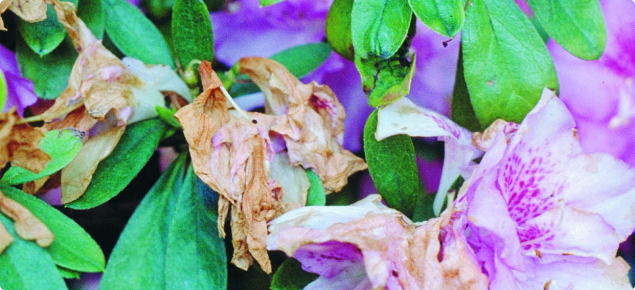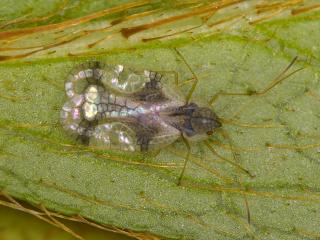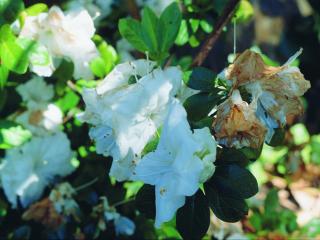Azalea lace bug
Identification and symptoms of attack
Azalea lace bug (Stephanitis pyrioides) is an introduced insect. Its common name comes from the raised network of veins on its clear, hardened forewings.
Adults are 4–6mm long, and mottled black and tan. Nymphs (juveniles) are similarly coloured, but smaller and spiny in appearance, and they undergo a number of moults before they reach maturity.
Lace bugs congregate on the undersides of azalea and rhododendron leaves. There they suck out the sap, robbing the plant of nutrients and causing the leaves to turn speckled grey-brown or silvery. The nymphs excrete honeydew, a sugary liquid on which sooty mould develops. If this coating becomes dense it decreases photosynthesis, further reducing the plant’s health.
The damage is similar to that caused by thrips. To find out whether lace bugs are the cause, beat the affected foliage over a white cloth or paper where any insects that fall can be seen easily. Cast skins shed by the nymphs are another clue to lace bugs’ presence.
Management and control
To avoid over-use of chemicals, try to exercise tolerance whenever possible. A little damaged foliage can be pruned, and minor occurrences of lace bug do not harm the plant seriously. Often the general condition of the plant is the factor that determines the scale of attack, making an azalea growing in a hot sunny location, where it suffers water stress, more vulnerable than a plant growing in the shade.
In the event of heavy infestations, spraying azaleas with a systemic insecticide – which the bugs ingest when they suck the sap – is effective but timing is crucial. Lace bugs do not travel far or fast and it takes a long while for them to reach harmful numbers. So, provided the spray is timed correctly, a single treatment should be enough to kill a localised infestation and prevent a recurrence for one or maybe even two years.
Lace bugs go through several generations during summer, so spraying the azaleas then is futile because eggs are constantly hatching. However, eggs laid in autumn lie dormant over winter and hatch in spring. The new season’s nymphs do not emerge all at one moment, so spraying too early will kill only the first of them. But one application of a systemic insecticide containing imidacloprid or acetamiprid in late to mid spring will kill the later emerging nymphs as well as the earlier ones before they reach adulthood.
An organic control is horticultural soap.
Azalea petal blight
Symptoms of infection
Petal blight in azalea species and cultivars is caused by Ovulinia azaleae, a fungal disease. The first signs are small spots that look water-soaked. These enlarge rapidly and merge. Within two or three days, whole flowers become limp and slimy, and then turn light brown. The rotted flowers do not drop readily and, when they do, tend to adhere to the foliage where they can remain stuck for many weeks.
Life cycle of the fungus
Ovulinia azaleae over-winters in the form of sclerotia (hard-coated survival bodies) on the previous season’s diseased flowers, or in the surface soil and leaf litter beneath the plant. When the azalea is nearing its flowering time, the sclerotia germinate. Small, almost microscopic, cup-shaped fruiting bodies are produced, from which spores are discharged.
Moist conditions allow the disease to develop. Periods of frequent rainfall or misty weather that coincide with flowering time will accelerate the rate of infection. Overhead watering has the same effect.
Control
To begin the new season well, pick off any diseased flowers that have hung on from the previous year and remove leaf litter from beneath infected plants.
By the time spots appear on the petals of the new season’s flowers, it is usually too late to combat the disease with fungicide. However, fungicide can be used as a protector if applied just before bud opening. The best time to spray is when the green buds begin to show their flower colour.
Apply a systemic fungicide with tebuconazole and trifloxystrobin every 14 days until the end of flowering or mancozeb with sulphur every 10 days until flowering finishes.
Unfamiliar pests
The Department of Agriculture and Food, Western Australia (DAFWA) is on the lookout for animal and plant pests, diseases and weeds that could pose a threat to agriculture and the environment.
If you discover something unfamiliar please send a photo to the Pest and Disease Information Service (PaDIS) by email: info@agric.wa.gov.au or phone them on Freecall: 1800 084 881.
Please read the sending specimens for identification web article before sending samples to the Pest and Disease Information Service, 3 Baron-Hay Court, South Perth, 6151, WA.




